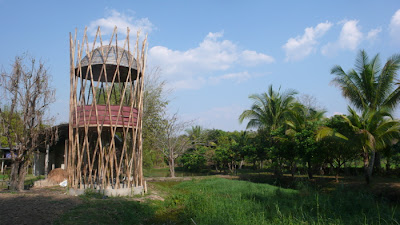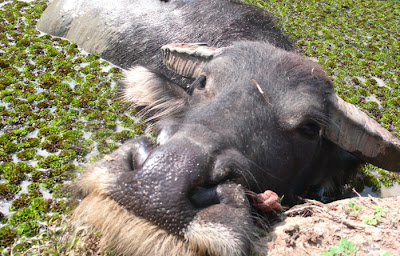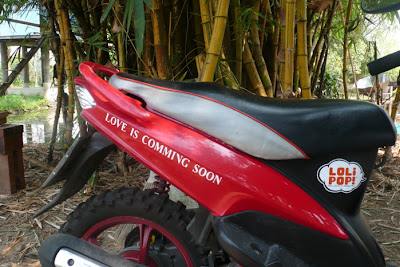 In our last night in Chiang Mai, we gathered with artists and friends on the sixth floor of our guest house, a rooftop space not yet installed with windows or walls. With a dozen liters of Singha and a bucket of ice brought over from a friend's bar, our after-hours party was powered by tinny music streaming from a Powerbook and a slideshow of images from "the land," the sustainability project/art community some 30 km away near Sanpatong. We stayed at the land one night, sleeping in a bamboo tower made by an artist/massage therapist duo under mosquito netting and waking to the chatter of geckos and birds, the caws of roosters and the occasional ox grunt.
In our last night in Chiang Mai, we gathered with artists and friends on the sixth floor of our guest house, a rooftop space not yet installed with windows or walls. With a dozen liters of Singha and a bucket of ice brought over from a friend's bar, our after-hours party was powered by tinny music streaming from a Powerbook and a slideshow of images from "the land," the sustainability project/art community some 30 km away near Sanpatong. We stayed at the land one night, sleeping in a bamboo tower made by an artist/massage therapist duo under mosquito netting and waking to the chatter of geckos and birds, the caws of roosters and the occasional ox grunt.With us on the roof were two artists who are part of the land's One-Year Project 2, American Alex ("Lek," in Thai) Wang and Norwegian Marius ("Madu") Notvik. As photos of farming, fishing, trips to the market and shared meals popped up, one of the two made a comment to this effect: It's so beautiful I hardly recognize it.
 That's the thing about the land. It's one thing to experience it and entirely another to witness it through mediation. Seeing photos, you can get a romantic view of the place, and it is romantic, in a way. International artists mix with Chiang Mai locals to discuss art and Vipassana meditation, to grow rice (the excess goes to an orphanage for kids with AIDS in Sanpatong), build experimental housing, and test new ideas (Madu is building a wood-fired oven, while Lek is making a chicken coop island which will float on one of the ponds).
That's the thing about the land. It's one thing to experience it and entirely another to witness it through mediation. Seeing photos, you can get a romantic view of the place, and it is romantic, in a way. International artists mix with Chiang Mai locals to discuss art and Vipassana meditation, to grow rice (the excess goes to an orphanage for kids with AIDS in Sanpatong), build experimental housing, and test new ideas (Madu is building a wood-fired oven, while Lek is making a chicken coop island which will float on one of the ponds). But the pictures don't convey the dry heat, the painful pinch of the relentless fire ants, the stink of buffalo poop, or the slippery slime of the klong, a drainage canal kept clean enough for bathing by powerful currents.
But the pictures don't convey the dry heat, the painful pinch of the relentless fire ants, the stink of buffalo poop, or the slippery slime of the klong, a drainage canal kept clean enough for bathing by powerful currents.None of this is bad; it's just... real. Having stayed there -- and enjoyed myself thoroughly -- I know understand what curator Karen Demavivas meant when she wrote that the land is an “ephemeral utopia of cracks, leaks, buffalo waste, termites, big red ants, rainy seasons and mold, a whirl of decay and renewal."
 The question that seems important to off-site critics is whether the project itself "is art" or not. Sure, the concept of the land is a compelling one -- how art can model solutions for sustainability, community, and, in the case of Kamin Lertchaiprasert's meditation, spirituality -- and it's been written about by everyone from Artforum's Tim Griffin to, well, me. But on the ground, the question feels less relevant. The land is a community, first and foremost. And the planting and cooking and brainstorming seem more about living than high-minded ideals about aesthetics or artistic concepts. Whether it is art or whether the community that shapes it sparks future art isn't a point I'm especially concerned with parsing.
The question that seems important to off-site critics is whether the project itself "is art" or not. Sure, the concept of the land is a compelling one -- how art can model solutions for sustainability, community, and, in the case of Kamin Lertchaiprasert's meditation, spirituality -- and it's been written about by everyone from Artforum's Tim Griffin to, well, me. But on the ground, the question feels less relevant. The land is a community, first and foremost. And the planting and cooking and brainstorming seem more about living than high-minded ideals about aesthetics or artistic concepts. Whether it is art or whether the community that shapes it sparks future art isn't a point I'm especially concerned with parsing. What I enjoyed the most about being at a place made famous in part by art stars like Rirkrit Tiravanija, Atelier van Lieshout, Superflex, Philippe Parreno and Francois Roche, was the utter lack of art-world gloss. And my admiration, to be frank, is less for those great artists who pop in, as I did, for a few days, than to the local artists who maintain the place, physically and intellectually, through farming and regular Friday night art talks. In the end, I'm glad, though, that the project falls under the label "contemporary art." While the term sometimes umbrellas values and people I'm not especially fond of, this endeavor is one by good, talented people who strive to imbue art with the very best of ideals.
What I enjoyed the most about being at a place made famous in part by art stars like Rirkrit Tiravanija, Atelier van Lieshout, Superflex, Philippe Parreno and Francois Roche, was the utter lack of art-world gloss. And my admiration, to be frank, is less for those great artists who pop in, as I did, for a few days, than to the local artists who maintain the place, physically and intellectually, through farming and regular Friday night art talks. In the end, I'm glad, though, that the project falls under the label "contemporary art." While the term sometimes umbrellas values and people I'm not especially fond of, this endeavor is one by good, talented people who strive to imbue art with the very best of ideals. See more images from "the land" at our Chiang Mai Flickr set.
See more images from "the land" at our Chiang Mai Flickr set.
No comments:
Post a Comment